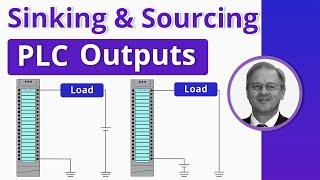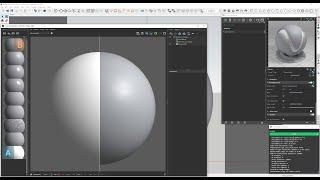
Sinking and Sourcing PLC Outputs Explained
▶ C'mon over to https://realpars.com where you can learn PLC programming faster and easier than you ever thought possible!
=============================
▶ Check out the full blog post over at
https://realpars.com/sinking-output/
=============================
⌚Timestamps:
00:00 - Intro
00:56 - Sinking and sourcing
02:17 - PLC digital output modules
02:32 - 1) Sinking output modules
02:49 - 2) Sourcing output modules
03:20 - PNP and NPN modules
04:45 - MOSFET modules
05:05 - Siemens 8 DO transistor module
05:38 - A quick way to identify sinking or sourcing
=============================
In this video, we’re going to talk about Sinking and Sourcing PLC digital output modules and how they connect to field devices.
Digital output modules can be Solid State or dry Relay.
The purpose of a PLC Digital Output module is to operate or control a DC voltage physical device based on field device conditions connected to an input module and decisions made by the PLC program.
When we talk about sinking and sourcing, it’s all about defining the direction of conventional current flow between 2 devices.
Think of it this way… Current is flowing between Device #1 and Device #2.
Which direction is the current flowing?
- The current is flowing from Device #1 to Device #2. Therefore we say Device #1 is Sourcing the current, and Device #2 is Sinking the current.
- What if the current was flowing from Device #2 to Device #1?
In this case, we say Device #2 is Sourcing the current, and Device #1 is Sinking the current.
In every situation where you have a current flow between 2 devices, one of the devices will be Sourcing and the other will be Sinking.
1) Sinking output modules
Let’s have a look at 2 devices with current flowing between them. One device is a PLC Output Module, and the 2nd device is a relay.
Based on the connection polarity, the Sinking module will have the current flowing into it from the load.
2) Sourcing output modules
Let’s do that again, but this time one of our devices will be a Sourcing module. Based on the connection polarity, the sourcing module will have the current flowing out of it and into the load.
If you recall, earlier we said that when there are 2 devices with current flowing between them, one device will be sourcing and one will be sinking.
Sometimes adding confusion to already murky concepts, some vendors refer to Sinking and Sourcing outputs as NPN and PNP outputs.
- An NPN Module is a Sinking module
- A PNP Module is a Sourcing module
Why are the names PNP and NPN used?
Whether it’s sinking or sourcing, an output module must act as a closed switch to complete the circuit.
In many output modules the actual switching is performed by Bipolar Junction Transistors (BJTs):
- In a Sinking module, the transistor is an NPN
- In a Sourcing module, the transistor is a PNP
The current flows into a sinking module and out of a sourcing module.
If a PLC output module is listed as an NPN type, you can be sure that it is a Sinking type. But, if a PLC module is listed as a Sinking type, it may or may not be an NPN type.
Many vendors use other solid state devices such as MOSFETs to perform the switching.
For example, we have the following Sinking and Sourcing modules:
6ES7322-1BP50-0AA0 https://bit.ly/3XCf6hC
6ES7322-1BP00-0AA0 https://bit.ly/44vvP8x
Unless we dig deeper, we can’t know for sure what type of switching device is used.
The Siemens 6ES7322-1BF01-0AA0 (https://bit.ly/3JKhWeR) is an 8 output Transistor Output Module.
This output module is a Sourcing module as the current flows out of the module and into the loads.
If this module is incorrectly wired as a Sinking module, it will not operate.
Is there a quick way to identify if a module is sinking or sourcing?
- If the wired-together load terminals connect to the plus terminal of the power supply, you have a Sinking module.
- If the wired-together load terminals connect to the negative terminal of the power supply (ground), you have a Sourcing module.
=============================
To learn more, you might want to review our other articles:
PLC Digital Output Types | Solid State vs Relay https://realpars.com/plc-output/
PLC Hardware Explained https://realpars.com/plc-hardware/
=============================
Missed our most recent videos? Watch them here:
https://realpars.com/instrument-calibrator
https://realpars.com/plcnext-starterkit
https://realpars.com/motor-starter
=============================
To stay up to date with our last videos and more lessons, make sure to subscribe to this YouTube channel:
http://bit.ly/realpars
=============================
TWEET THIS VIDEO https://ctt.ac/sc4NT
=============================
Follow us on Facebook: https://www.facebook.com/therealpars
Follow us on Twitter: https://twitter.com/realpars
Follow us on LinkedIn https://www.linkedin.com/company/realpars
Follow us on Instagram https://www.instagram.com/realparsdotcom
#RealPars #Industry #automationengineer
=============================
▶ Check out the full blog post over at
https://realpars.com/sinking-output/
=============================
⌚Timestamps:
00:00 - Intro
00:56 - Sinking and sourcing
02:17 - PLC digital output modules
02:32 - 1) Sinking output modules
02:49 - 2) Sourcing output modules
03:20 - PNP and NPN modules
04:45 - MOSFET modules
05:05 - Siemens 8 DO transistor module
05:38 - A quick way to identify sinking or sourcing
=============================
In this video, we’re going to talk about Sinking and Sourcing PLC digital output modules and how they connect to field devices.
Digital output modules can be Solid State or dry Relay.
The purpose of a PLC Digital Output module is to operate or control a DC voltage physical device based on field device conditions connected to an input module and decisions made by the PLC program.
When we talk about sinking and sourcing, it’s all about defining the direction of conventional current flow between 2 devices.
Think of it this way… Current is flowing between Device #1 and Device #2.
Which direction is the current flowing?
- The current is flowing from Device #1 to Device #2. Therefore we say Device #1 is Sourcing the current, and Device #2 is Sinking the current.
- What if the current was flowing from Device #2 to Device #1?
In this case, we say Device #2 is Sourcing the current, and Device #1 is Sinking the current.
In every situation where you have a current flow between 2 devices, one of the devices will be Sourcing and the other will be Sinking.
1) Sinking output modules
Let’s have a look at 2 devices with current flowing between them. One device is a PLC Output Module, and the 2nd device is a relay.
Based on the connection polarity, the Sinking module will have the current flowing into it from the load.
2) Sourcing output modules
Let’s do that again, but this time one of our devices will be a Sourcing module. Based on the connection polarity, the sourcing module will have the current flowing out of it and into the load.
If you recall, earlier we said that when there are 2 devices with current flowing between them, one device will be sourcing and one will be sinking.
Sometimes adding confusion to already murky concepts, some vendors refer to Sinking and Sourcing outputs as NPN and PNP outputs.
- An NPN Module is a Sinking module
- A PNP Module is a Sourcing module
Why are the names PNP and NPN used?
Whether it’s sinking or sourcing, an output module must act as a closed switch to complete the circuit.
In many output modules the actual switching is performed by Bipolar Junction Transistors (BJTs):
- In a Sinking module, the transistor is an NPN
- In a Sourcing module, the transistor is a PNP
The current flows into a sinking module and out of a sourcing module.
If a PLC output module is listed as an NPN type, you can be sure that it is a Sinking type. But, if a PLC module is listed as a Sinking type, it may or may not be an NPN type.
Many vendors use other solid state devices such as MOSFETs to perform the switching.
For example, we have the following Sinking and Sourcing modules:
6ES7322-1BP50-0AA0 https://bit.ly/3XCf6hC
6ES7322-1BP00-0AA0 https://bit.ly/44vvP8x
Unless we dig deeper, we can’t know for sure what type of switching device is used.
The Siemens 6ES7322-1BF01-0AA0 (https://bit.ly/3JKhWeR) is an 8 output Transistor Output Module.
This output module is a Sourcing module as the current flows out of the module and into the loads.
If this module is incorrectly wired as a Sinking module, it will not operate.
Is there a quick way to identify if a module is sinking or sourcing?
- If the wired-together load terminals connect to the plus terminal of the power supply, you have a Sinking module.
- If the wired-together load terminals connect to the negative terminal of the power supply (ground), you have a Sourcing module.
=============================
To learn more, you might want to review our other articles:
PLC Digital Output Types | Solid State vs Relay https://realpars.com/plc-output/
PLC Hardware Explained https://realpars.com/plc-hardware/
=============================
Missed our most recent videos? Watch them here:
https://realpars.com/instrument-calibrator
https://realpars.com/plcnext-starterkit
https://realpars.com/motor-starter
=============================
To stay up to date with our last videos and more lessons, make sure to subscribe to this YouTube channel:
http://bit.ly/realpars
=============================
TWEET THIS VIDEO https://ctt.ac/sc4NT
=============================
Follow us on Facebook: https://www.facebook.com/therealpars
Follow us on Twitter: https://twitter.com/realpars
Follow us on LinkedIn https://www.linkedin.com/company/realpars
Follow us on Instagram https://www.instagram.com/realparsdotcom
#RealPars #Industry #automationengineer
Тэги:
#Sinking_and_Sourcing_PLC_Outputs_Explained #6ES7322-1BF01-0AA0 #is_npn_sinking_or_sourcing? #PLC_Digital_Output_module #PLC_Output_module #Siemens_6ES7322-1BF01-0AA0 #sink_output_circuit #Sinking_and_Sourcing #sinking_and_sourcing_in_plc #sinking_digital_output #Sinking_module #Sinking_Output #sinking_output_vs_relay_output #Sinking_PLC_Outputs #sinking_signal #sinking_vs_sourcing #Sourcing_module #Sourcing_PLC_Outputs #types_of_PLC_output_modules #What_is_a_sinking_outputКомментарии:
Making A Baby Red Panda l DIY Art Doll Tutorial
KaypeaCreations
Buying Every Club League Skin
CryingMan
Лечо на зиму с баклажанами, помидорами и перцем | Lecho for the winter with eggplant
Кулинарим с Светланой Железняк
ПРОФЕССИЯ - РЕПОРТЕР / ШАКИР УМАРОВ
MillionNick
Plastic Material in V-Ray 5 for SketchUp
SketchUp V-Ray
5 Things to Know When Buying a Steinway Piano
Lindeblad Piano Restoration


























